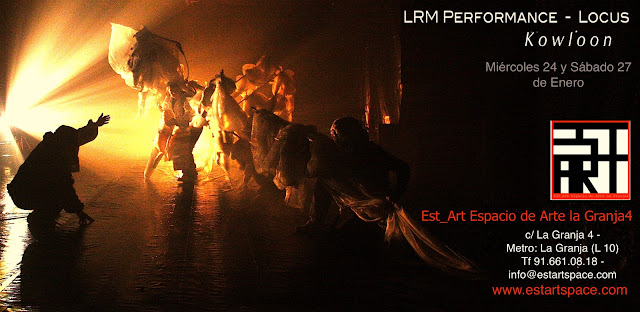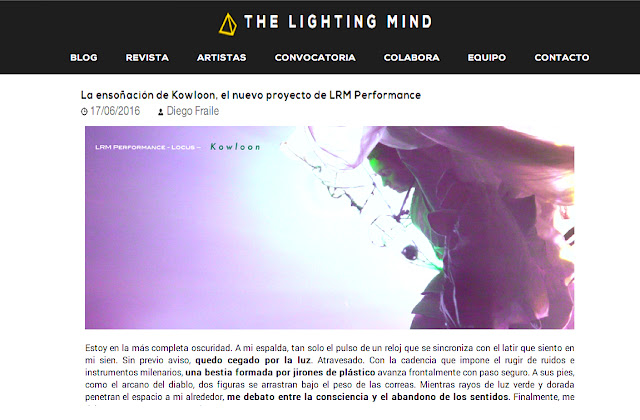This is the translation of the critique
– almost an essay– on LRM Locus' Kowloon, by Angel Alonso,
There is a backdrop
Kowloon, by LRM Performance-Locus
Angel Alonso
LRM Performance - Locus invited me few weeks ago to a private pass of their new work, entitled 'Kowloon'. I did not know what was I going to witness. I had only seen some photographs. In addition, members of LRM Locus told me about their interest in Tsai Ming-liang, Roy Andersson, Andrei Tarkovsky, Apichatpong Weerasethakul or Fruit Chan's films. Perhaps that is why I began to wonder how invoking the cinematic memory within the transience of a performance would be. And it certainly stirred such visual memory, but in a much different way than I could have imagined.
Somehow, for this text I try to follow their work's game proposal and build up a non-narrative description of the piece. Therefore, in the following lines descriptions of specific moments of the piece are mixed with personal references to the world that was stirred up in me when attempting to come back to Kowloon.
Before me, a closed drape. And behind it some sort of corridor. There has to be a wall at the end. But I cannot see it and I want to touch it, when suddenly comes to my mind a television image which may not exist but I want to remember: someone runs down a corridor which ending wall inescapably falls away.
I need to remember that image because I also need to touch what just appeared between the backdrop and that wall I feel moving away. But I can't, and because of it, I remember. Perhaps next time I may be able to touch that threatening, virginal and set adrift realm. Yes, perhaps the next step of LRM Locus will be allowing me to touch what I believe are sea creatures or arborescent crustacea. Or maybe they will allow me to caress and look carefully at it all when the lights come back on and Kowloon is gone. But I'm still in the darkness and I feel the sea so close inside the hall that the sound of a door is like a ship about to wreck to me. Threatening worlds you want to get closer to, a bit like what happened to David Drayton in The Mist (Frank Darabont, 2007), when he got out of a car and watched the solemn wandering gigantic creatures coming with mist from another world destroying anyone who dared in.
Kowloon seems also menacing, yet some drops dripping from it and a glimpse between its darkness make it more beautiful than sinister. Three body shaped drops walking around an ocean expelled as to pack it with walls, ratlines or sails to unfurl while the wind is being counted.
Those bodies also fear the sea and its creatures, they look at it downcast and in quick glances, discovering it in flashes of light. They may be inside an animal, as they say Jonah was in a whale. Sometimes they touch the creature and the inside of her womb, or go to the remains of their wrecked barge.
One of them tapped a wall. Looks with its hands, not its eyes. And I feel the joy of hands sliding to touch, just for such joy, fear and faith they have when facing the unexplored, now that their eyes did not succeed in gazing and felt beaten from the distance by something unknown. Hands raised towards a new world, as if this quite determined item towards which we project [1] requests it, and they had to respond, touching, to the call of the seemingly ignoble materials of Kowloon.
while hands are raining,
light hands, selfish hands, obscene hands,
waterfalls of hands that once were
flowers in the garden of a tiny pocket. [2]
Long time must have passed since I found them at the bottom of that ocean, for suddenly the flowers appear scattered over the body of one of the inhabitants of Kowloon. And the flowers are different, and also fossilized because, in a muddy cave on a remote system or at the bottom of the ocean, minutes are traveled as decades. Bodies that lost their human appearance in a liquid world –for the sea can do anything, as Ariel said to Ferdinand in The Tempest (William Shakespeare, 1611) with a ballad tone that always comes to me when a person is masked with plastics resembling lichens:
Full fathom five thy father lies;
Of his bones are coral made;
Those are pearls that were his eyes:
Nothing of him that doth fade,
But doth suffer a sea-change
Into something rich and strange. [3]
Then again, how long have they been in Kowloon so that their bodies changed? How much time did unfold before me while lights blink on and off? Did their bodies journey through the different ages of that world or did they simply create new galleries that take it away from me and it becomes strange again? Or maybe I did not even see the same bodies all the time and before me passed, generation after generation, all descendants of those three beings who arrived there one day.
I believe every slight flash of light showing me again that corridor which wall I still cannot gaze at, was enshrining all the Kowloons I once lived in as a traveler or watched on a screen. The experience of shutting and opening your eyes -of interrupted lights - placed me beyond any chronology and yet, allowed me to remember all the stories and lives I inadvertently wished for. It was only a fifty minute trip and escape. While that piece of Hong Kong made me open my eyes to shut them out immediately, the experienced sensation of light taking place at a given time was the condensation of an extraordinarily incomprehensible story, which unfolded in a stumbling world I could only snatch a wisp from.
There lie, succeeding each other, trillions of oscillations, that is, a series of events such that if I wanted to count them, even with the greatest possible economy of time, would require thousands of years. [4]
Images from Kowloon, by LRM performance–Locus, (2016)
and The Mist (Frank Darabont, 2007)
[1] Merleau-Ponty, Maurice, Phénoménologie de la Perceptión (1945)
[2] Cernuda, Luis, Qué ruido tan triste (1931)
[3] Shakespeare, William, The Tempest (1611), Ariel's Song
[4] Bergson, Henri, L'Énergie spirituelle (1919)































